In our last blog post, we discussed the benefits and risks of many of our favorite chews. Chewing/gnawing is how our dogs and cats have evolved to keep their teeth clean. However, some of our animals (some seniors, some with a history of extractions, etc) aren’t able to chew and gnaw as easily as others. This post is a discussion of other ways to provide oral care.
Check out the similarity of the tiger and the house cat teeth, and between the Wolf skull and the dog’s teeth below it. You can always tell what any animal is designed by evolution to eat by studying the shape and size of their teeth. Compare the tiger and house cat photos, and compare the wolf skull and dog teeth below:
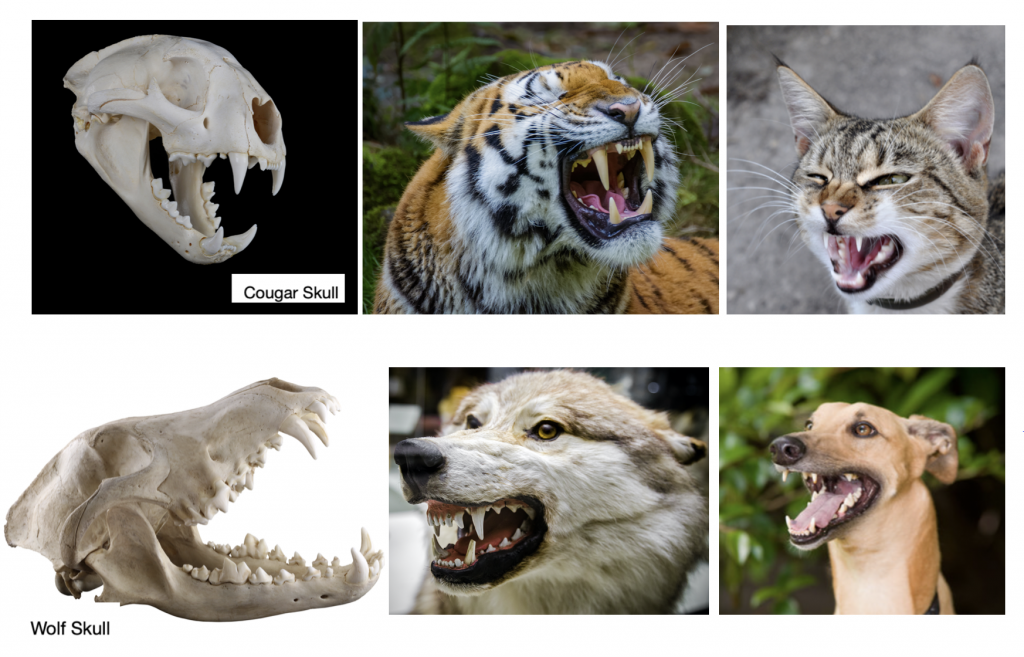
All images licensed from Adobe
We want to begin by reminding you that unfortunately, eating a kibble diet does not count as “chewing”.
A carnivore’s teeth are designed to tear and shear meat. Their jaws are designed to move the jaw up and down, but not side to side for chewing or grinding. The shape of our little carnivores’ teeth have not changed one bit in their evolution from their wild ancestors. Our dogs and cats, like coyotes, wolves, tigers and leopards (and even saber-toothed tigers), have specialized carnivorous molars called carnassial teeth designed to shear flesh and bone like scissors. At best they crack and swallow kibble diets, but the outer surfaces of those molars and the surfaces of the teeth along the gum line aren’t being scraped by the crunchy kibbles. The way they have evolved to clean their teeth is to chew through meat and bone and connective tissue with these back molars, which stimulates the gum line and scrubs those back teeth of the biofilm that can accumulate and turn to plaque.
Another problem with kibble that contributes to dental trouble is its high starchy carbohydrate content. Just like with humans, these simple carbohydrates can linger in their mouths and then break down into simple sugars. Bacteria feeds on these sugars and produces acid, which causes tooth decay. No one would argue that humans could clean their teeth simply by eating a lot of crunchy pretzels, but many do argue that dogs and cats should eat dry food to clean their teeth.
The best diet for overall health and dental health is a whole food diet with meat, organs and a few veggies (more for dogs than cats), and skipping the starchy carbs completely. See below in the cheese section for some of the benefits. This kind of diet doesn’t need to be an “all or nothing” proposition – even one 1oz nugget per day, or one on each meal can make an impact on their general health! The brands we carry are very safe to feed, and are often cheaper than feeding canned food! (More info on feeding raw here)
Here are some additional products, tricks and tips that will help all animals to keep their teeth and gums healthy:
BRUSHING TEETH!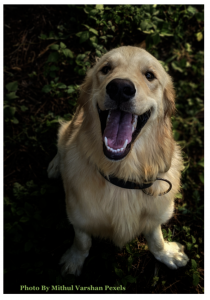
No doubt, we know the most important thing humans can do to keep our teeth and gums healthy is brush, and the same can be said for our pets. I can hear you moaning from here…. I know that this isn’t necessarily the easiest thing to do with some animals, but it’s worth working on!
For those of you with puppies and kittens, now is the easiest time to desensitize them to this sort of activity. A puppy’s mouth is changing rapidly, and vigorous brushing is not recommended when they have their baby teeth, but getting them used to you looking into their mouths and inspecting their teeth and gums is incredibly important, especially later in life. What if your dog has chewed a stick and you can’t check if a splinter of wood is lodged in the gum? What if your cat isn’t eating well and you’re accusing her of being picky, when actually she’s in pain from inflamed gums? If your senior dog was developing a tumor in her mouth, would you be able to catch it early? Being able to check the color of the gum tissue can also really help to assess an animal’s hydration and alert you to medical problems – the gums can change color, becoming pale from anemia or yellow from liver issues, red from heat stroke or blue from lack of oxygen. They can also be a good indicator of shock: when you press on the gum tissue and the circulation returns to that spot within a second or two, all is well.
Any animal might learn to accept more inspections of the mouth and eventually allow brushing, but the key is not to just jump right in there and start scrubbing the first day.
Start by gently lifting the lip/jowl to take a peek and immediately reward with a tasty treat (perhaps a lick of an enzymatic toothpaste from your finger could be a good reward if they love the flavor. Never use human toothpastes, which are not meant to be swallowed).
The next step might be to rub a bit of that toothpaste along their gumline with your finger. The yummy toothpaste left behind can be a good immediate reinforcer for this step of the process. When desensitizing any animal to new handling routines, respect any small signs that the process is stressful, like seeing the whites of their eyes, tucking their tail, or trying to get away. You want them to enjoy the process, so go backwards to a version of the activity that didn’t make them uncomfortable and just stick with that for a while, rewarding every time. Build up more slowly to your goal, and only make it a little harder when they’re happy with the activity. Even if you can only get as far as being able to regularly look at the teeth and gums, consider it a win!
You could progress from using your finger to rub their gumline to using a piece of gauze with toothpaste on it (dog toothpaste only- never toothpastes for humans), to perhaps a finger brush for bigger animals. If they’re leery of the toothbrush coming at them, you can choke up on it at first so your index finger is on the back of the brush where the bristles are, to hide the look of coming at them with a big tool.
When brushing it’s not important to focus on the front teeth or to brush the insides of the teeth – your main goal is maintaining the outer surfaces of the back teeth and gums.
A few tips: You can brush facing them head on, or you might be more successful being right behind them, lifting their chin and brushing downward towards their back teeth. For cats and very small dogs you might check out the drug store for a product called Wisp, which is supposed to be a tiny quick travel toothbrush for people, but MAKE SURE to remove the little hard blue bead of toothpaste that it comes with.
If you’re brushing your teeth, perhaps call them into the bathroom with you and brush their teeth after you brush yours. This will help you remember to do it, and to give them a cue that it’s time for their yummy peanut butter or chicken toothpaste activity. If you forget to call them, they might hear you brushing and come running in for their turn. Even if you don’t get as far as brushing, if you can rub enzymatic toothpaste along their gums daily, you’re going to be doing something positive for their oral health.
Tips for brushing your cat’s teeth:
It can be done! If you have a kitten, we’d recommend following the steps for puppies outlined above. Take it slowly and do not force them into anything. Reward it well, and you might just be able to do more than you think. Check out this great post by Dr. Karen Becker, DVM on how to brush a cat’s teeth. Note: some cats who won’t allow brushing (like our Otis) might very well be willing to just bite down on the bristles of a toothbrush with kitty toothpaste pushed into the bristles. We would let Otis chew on the brush facing up, and then facing down. (Note: Dr Becker is no longer associated with Dr Mercola.)
It’s worth working on. Tooth and gum problems are expensive! Tooth brushing is just about free…
PLAQUE OFF!
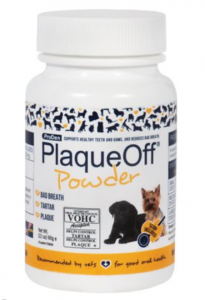
Photo from Proden Plaque Off
What a tremendous help this supplement is!! We’ve carried it for nearly the entire 18+ years we’ve been open, and have seen amazing results. It’s a granular powder made from a certain kind of kelp, which according to clinical trials helps to break down the biofilm (the slimy buildup of bacteria that forms on the surfaces of teeth and hardens into plaque). It helps to prevent plaque buildup and breaks down the bond between the plaque and the tooth so it can more easily be removed with chewing action.
Within 2 weeks we see better breath, and within 6-8 weeks we see visible changes in the amount of plaque on the teeth. The dose is small, and it doesn’t taste like much (sort of like sushi wrapper) so it’s easy to hide.
A bit of impressive trivia: The makers of Plaque off for pets also makes a human version (it’s the exact same powder, in capsules). Customers had sometimes remarked to us that it had worked so well for their pets that they wished they could be on it too, so we brought the human version in. No one bought it (part of the fun of retail when you take chances on a new product) but Mike and I started taking it (later I just put the pet powder into empty capsules). We both had a cleaning before we started taking it, then 6 months later when we went back to our dentist, both of our numbers for gum health were better! Later, during a time I felt lazy about putting the powder into capsules, we were off it for a time, and both of us saw those numbers get worse. We stay on it now.
The only animals that should not take it are those with hyperthyroid disease (which unfortunately mostly occurs in cats). See the last blog post for suggestions for cat chews. The reason for this is that kelp naturally contains iodine, which can stimulate the thyroid gland. If the gland is already overactive in animals with hyperthyroid disease, you wouldn’t want to over stimulate it. Animals without hyperthyroid disease should be jut fine on it, as a little bit of kelp has its own nutritional benefits! The small jar is $23.99 and should last about a year for a cat or a small dog. We have another version aimed at cats that has brewers yeast included for greater palatability. This would also be fine for picky dogs to use. Bigger containers of the original formula are available as well.
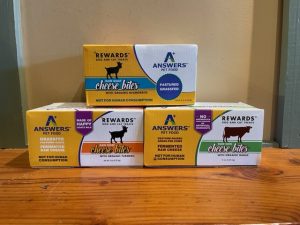
Photo By Green Dog Pet Supply
DELICIOUS AND NUTRITIOUS CULTURED RAW GOAT AND COW CHEESES ARE DENTAL SUPPLEMENTS!
These and the cow’s milk kefir cheeses are truly some of our favorite products, but they admittedly are a sleeper for us as they’re kept fairly out of sight in our freezers. First of all they’re delicious. When we’re sampling them out at the counter, I have trouble leaving any in the box for the dogs to try! They come in many organic flavors (goat = Cherry, Blueberry, Ginger, Turmeric, Cranberry. Cow = Cumin, Turmeric with black pepper, and garlic (my favorite). These are raw cheeses made with the milk from pastured, certified humanely raised, organically fed goats and cows, flavored with nutrient-rich flavors.“Cultured” means they are fermented like your yogurt might be. The benefits of the fermentation are vast (we should all be eating more fermented foods!) Fermented, raw foods are loaded with enzymes that can improve circulation, help speed tissue repair, and reduce pain, swelling, and inflammation —all helpful in healing gingivitis and gum disease. Answers products use fermentation to propagate probiotic bacteria. These good bacteria inhibit the growth of bad bacteria that cause oral disease (and also those bad bacteria that might cause safety problems!). By maintaining a healthy oral microbiome, these fermented foods help the mouth’s natural disease-fighting systems stay fully functional. Also, when the probiotics reach the gut, they improve the function of the systemic immune system which further helps to maintain their health, both oral and overall.
Cheeses that have been shown to help in decreasing the acidity in plaque (for humans too! Google which cheeses are best for human dental health). Cheese can also increase saliva flow, therefore helping wash away acids, sugar and bacteria on the teeth. Calcium and phosphates in milk and other dairy products help put back minerals that teeth might have lost due to other foods. Casein and whey protein also help rebuild tooth enamel.
The fact that they’re made with raw milk is key: Pasteurization or heating milk destroys most of its nutritive value. Heating destroys beneficial bacteria in raw milk. It denatures the natural digestive enzymes (when people have a milk sensitivity, they take lactase, an enzyme that is naturally found in raw milks but is destroyed by the pasteurization process). Heat processing also destroys the chemical make-up of calcium and other important nutrients to render them less absorbable.
Raw milk is rich in Vitamin K2, which assures proper placement of calcium. All these factors work together synergistically to keep the teeth and jaw bones strong and healthy. (Answers fermented bone broths also contain glycosaminoglycans (GAGs), which help repair compromised gum tissue and strengthen the ligaments that hold each tooth in place).
When pets bite into the cheese treats with their back teeth, they’re putting those amazing enzymes and probiotics (good bacteria) right where it needs to be to fight that bad bacteria.
Check out this silly video we made about goat cheese.
MAD ABOUT ORGANICS ORAL CARE PRODUCTS!
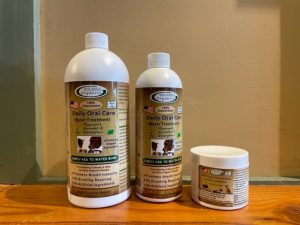
Photo by Green Dog Pet Supply
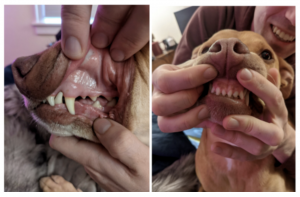
Photo By C. Miltenberger
Try to build oral care into your daily routine. For your pets that can chew, give them a little something to chew, even if it’s just a quick Whimzees stick for dogs, or a freeze dried chicken heart for cats or small dogs.

